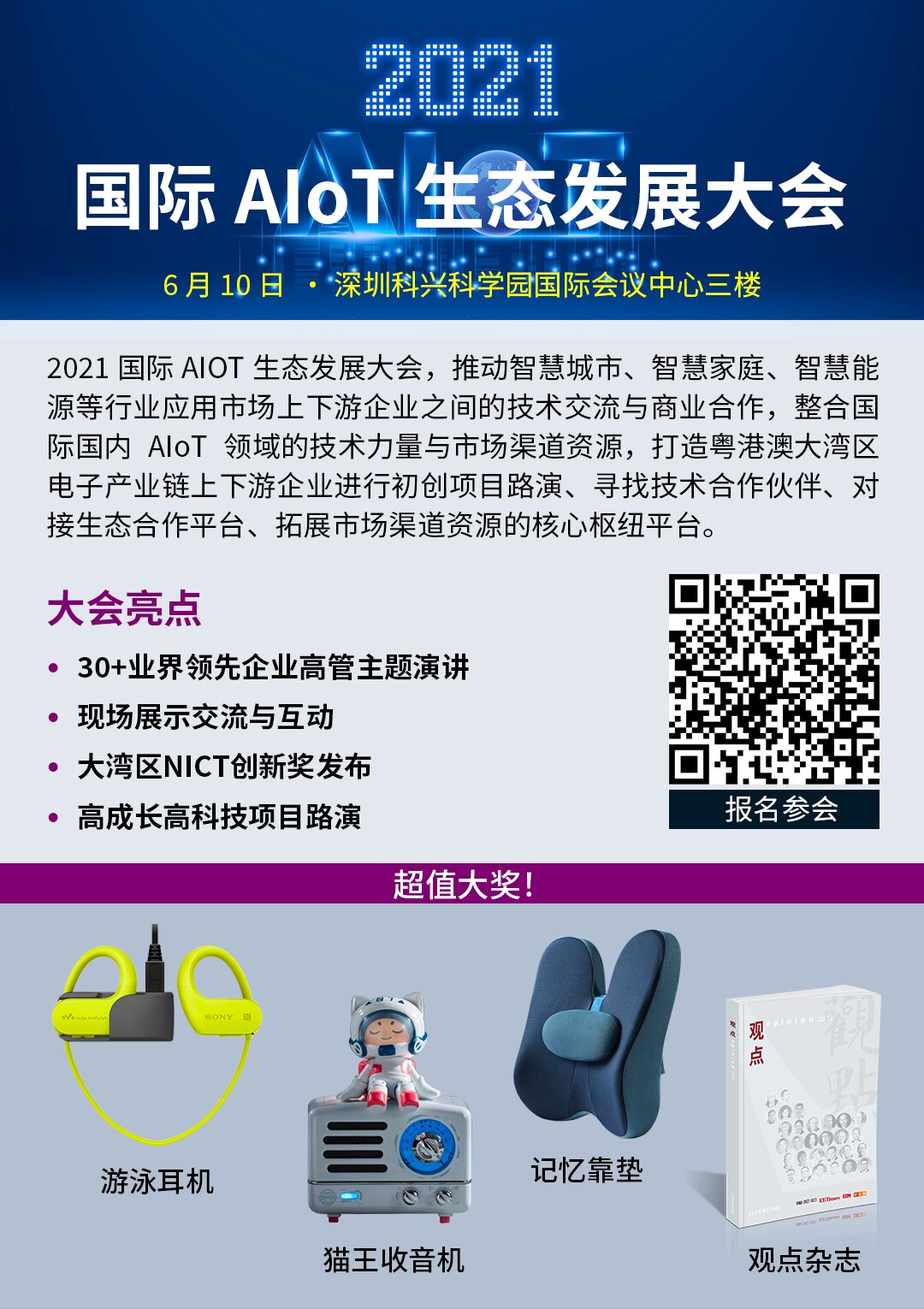
Author: Huang Yefeng
Original Article by EET Electronic Engineering Album
This year, one of the highlights of the iPad Pro 12.9-inch update is the use of a mini LED backlit screen. Many review articles describe the visual experience of mini LED as stunning. However, alongside the praise, many users have mentioned that the mini LED screen of the iPad Pro seems to have “flipped” due to the halo effect around displayed objects on a black background. The appearance of halos around displayed content is a technical topic worth discussing.
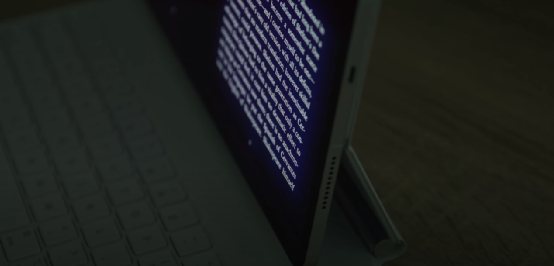
Source: The Verge
The image above comes from foreign media The Verge, showing the halo effect around text when reading in dark mode using the Kindle app or Apple Books. Of course, such a severe “halo” may be greatly related to software optimization. However, it is indeed an exaggerated representation of the limitations of mini LED lighting principles, which is helpful for understanding the halo effect.
In this article, we will discuss the principles and characteristics of mini LED backlit panels, as well as their value and development prospects, using the “halo effect” of the iPad Pro 12.9-inch as a reference. It is important to note that mini LED/micro LED is currently a major focus of development in the entire supply chain.
The Mini LED Screen of iPad Pro
The newly launched 12.9-inch iPad Pro uses a screen that Apple calls Liquid Retina XDR. Behind this marketing term is mainly the mini LED backlight technology. Before discussing mini LED technology, let’s take a look at how incredible this screen is.
First, the screen can achieve a brightness of 1000 nits, and when playing HDR content, the peak brightness can reach up to 1600 nits, which is comparable to the Apple Pro Display XDR monitor priced at 40,000 to 50,000 yuan. It is significantly brighter than most TVs on the market that claim to be 4K HDR. Other iPad Pro screens have a brightness of only 600 nits, and generally, high-end tablets and laptops have a brightness of about 500 nits.
Additionally, the contrast ratio of this screen reaches 1,000,000:1, which is also comparable to the Pro Display XDR priced at 40,000 to 50,000 yuan. Many users have reported that when viewing HDR content on this screen, the dark areas appear significantly darker while still presenting more detail. Although this contrast ratio may not be impressive compared to the iPhone 12 screen, it’s important to note that the iPhone 12 uses an OLED screen, while the iPhone 11 uses an LCD screen with a contrast ratio of 1400:1.
Some may ask, why not use an OLED screen directly? OLED panels are indeed feasible for small screens like smartphones, but for large-size panels, OLED technology is not cost-effective due to manufacturing costs. Moreover, while OLED has excellent dark performance and high contrast ratios, it is difficult to achieve the high brightness of LCD due to the lifespan of the light-emitting materials.
Although there are currently very few HDR content resources available in domestic video streaming, this screen can still outperform typical tablet and laptop screens in daily entertainment and office use.
Of course, Apple is not the first manufacturer to apply mini LED screens. TCL, Samsung, and LG have been promoting mini LED panels for the past two years. This year has been referred to by some manufacturers as the “year of mini LED panels” as mini LED panels are making a significant push into the market.
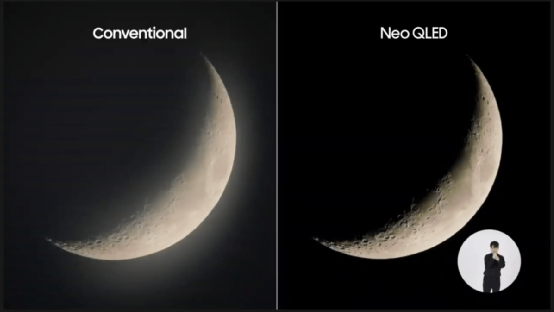
Source: Samsung
The Halo Effect of Mini LED
Having discussed the positives, let’s address the negatives. As mentioned at the beginning, the mini LED screen of the iPad Pro exhibits a “halo” effect in its display. This is determined by the characteristics of mini LED backlighting. To discuss this issue, we must first understand the display principles of LCD.
The detailed principles will not be elaborated here; the core related to its light-emitting principle is that the LCD panel is a layered structure, illuminated by the backlight layer at the bottom to display the picture; there is a liquid crystal layer (LC) in the middle that can control the passage of light through the deflection of the liquid crystals. For example, when displaying pure white, the liquid crystal “allows” all backlight to pass; while displaying pure black, the liquid crystal “blocks” the backlight.
This light-emitting principle of LCD determines that general LCD screens find it difficult to display true pure black. Because even if the liquid crystal “blocks” the backlight, it still cannot achieve complete blockage. Therefore, the black displayed on an LCD screen is more like a shade of gray rather than pure black. In contrast, OLED can completely “turn off” pixels when displaying black, resulting in a much purer black.
This also determines that LCD screens struggle to achieve high contrast ratios; traditionally, LCD screens with contrast ratios of 1000:1 to 5000:1 are already considered good. This makes it more challenging for LCD to achieve HDR (High Dynamic Range) content display. Hence, local dimming has emerged, where the backlight layer of the LCD is divided into different zones, lighting up only the necessary zones while turning off the backlight in areas displaying black.

Source: Samsung
This technology is widely used in LCD TVs, with high-end models like the Vizio P-Series Quantum X TV having up to 480 backlight zones. Many LCD TVs have dozens of LED backlight zones. If we compare “local dimming” to OLED, OLED can be likened to having independent “backlights” for each pixel. In other words, a 1080p resolution OLED panel has over 2 million “backlight zones” compared to the “local dimming” of LCD.
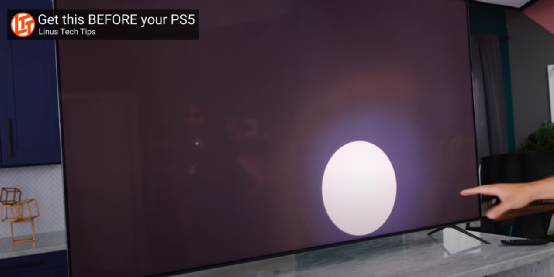
Source: Linus Tech Tips
When the granularity of local dimming is relatively coarse (i.e., the number of backlight zones is not many), it is easy to observe the “halo” effect, which is caused by light leaking from one lit zone to adjacent non-lit zones (or darker zones). Upon closer inspection, one might even discern different backlight zones with the naked eye.
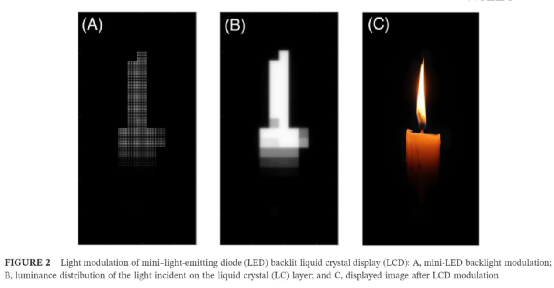
Source: Prospects and challenges of mini-LED and micro-LED displays*
Essentially, mini LED is about creating more of these backlight zones or making each LED backlight smaller to achieve more precise backlight and image brightness control (thus mini LED is still considered LCD). For example, in the image above, when displaying a candle, only the necessary backlight portions are illuminated, and there are different grayscale levels (though its precision still cannot compare to OLED).
Mini LED TVs typically have far more backlight zones than traditional LCD TVs (which varies based on panel size). For instance, TCL’s 8-series mini LED TV has over 25,000 mini LEDs, forming 1,000 zones.
Samsung’s Neo QLED TV, launched at CES 2021, claims that individual LEDs are 40 times smaller than traditional LEDs; it also emphasizes halo control. While Samsung did not specify how many backlight zones its Neo QLED TV has, some netizens estimate that the 85-inch QN90A model has about 1,320 backlight zones.
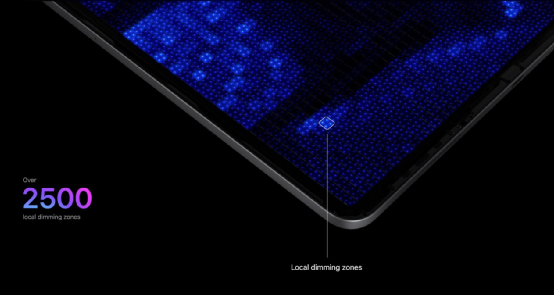
Source: Apple
This year’s iPad Pro 12.9″ also boasts a stunning configuration in mini LED backlighting. Apple states that this tablet’s screen has over 10,000 mini LEDs, forming 2,500 zones. It is notable that this screen is only 12.9 inches, much smaller than those TVs. In comparison, the previous generation iPad Pro had a total of 72 LEDs for backlighting. Thus, the size of individual LEDs in the new iPad Pro’s screen is approximately 120 times smaller than its predecessor.
While the number of zones sounds significantly higher than traditional LCD TV panels, as mentioned earlier, when compared to the pixel-level precision of OLED (or micro LED), it still falls short by more than one order of magnitude. Therefore, mini LED can alleviate the halo effect with more LEDs and zones, but it still cannot achieve pixel-level fine control, and the halo issue may persist.
A More Detailed Understanding of the Halo Issue
Although many people consider mini LED to be a transitional solution to OLED, the adoption of mini LED screens in the iPad Pro still showcases the bright prospects of this type of panel and indicates its feasibility for large-scale production and popularization. This technology not only allows LCDs to achieve higher contrast ratios and present darker blacks but also brings benefits in backlight uniformity, panel thickness, and power consumption; additionally, it is less expensive than OLED and can achieve higher peak brightness. The value of mini LED will not be further discussed in this article.
In the following sections, let’s take a closer look at the halo issue of mini LED and the additional challenges it faces. A paper titled “Prospects and challenges of mini-LED and micro-LED displays” presented at SID 2019 discussed the challenges faced by mini LED in detail.
The halo effect is a significant topic under local dimming technology. As mentioned earlier, the halo effect is the phenomenon of light leaking into adjacent black areas when displaying bright objects. Accompanying this is a clipping effect, which we will tentatively translate as a weakening effect, where the brightness of the zone’s light is insufficient.
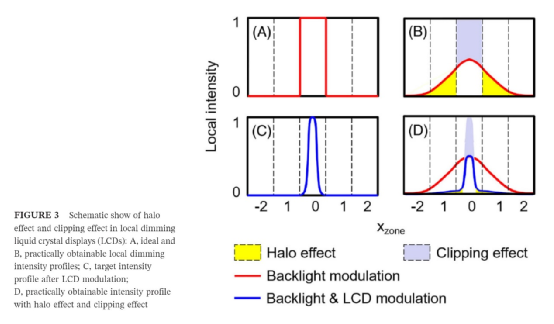
The image above explores the existence of these two effects. The horizontal axis (Xzone) represents different backlight zones, while the vertical axis indicates brightness. In this case, only the center zone is at peak brightness, while the surrounding zones are in an “off” state. Ideally, it should look like graph (A). However, in reality, the brightness of each zone is not only related to the light source itself but also to the light leakage from adjacent zones. Graph (B) illustrates this situation, where the light from the center zone leaks into the adjacent zone, and the brightness of that zone is weakened, resulting in both halo and weakening effects simultaneously.
On the other hand, the backlight units (BLU) of LCD panels modulate the LEDs further to achieve better detail representation, aiming for graph (C). Thus, adding the halo and weakening effects will ultimately lead to graph (D).
There are indeed many algorithms designed to mitigate these two effects, and manufacturers are working hard in this direction—various algorithms were proposed long before our awareness. From a hardware perspective, higher LCD contrast ratios or fine pixel-level dimming can significantly alleviate or eliminate these two effects. For LCD, this means increasing the number of backlight zones to reduce the dark areas affected by the halo effect (the yellow area in graph B); increasing the contrast ratio alleviates the halo effect in bright areas (the yellow part in the central zone of graph D).
The number of backlight zones and the contrast ratio of LCD have the most significant impact on suppressing halo and weakening effects; additionally, the diffusion of LED light and the isolation of zone light in optical design also affect the final performance of zoned dimming—differences in optical design may lead to fewer zones but better performance in suppressing halo effects.
Regarding whether the halo effect is perceivable by the human eye, researchers have previously proposed using LabPSNR (Peak Signal-to-Noise Ratio in the CIE 1976 L*a*b* color space) as a measure of the halo effect. When LabPSNR > 47.7dB, only 5% of people can distinguish whether mini LED backlighting is used.
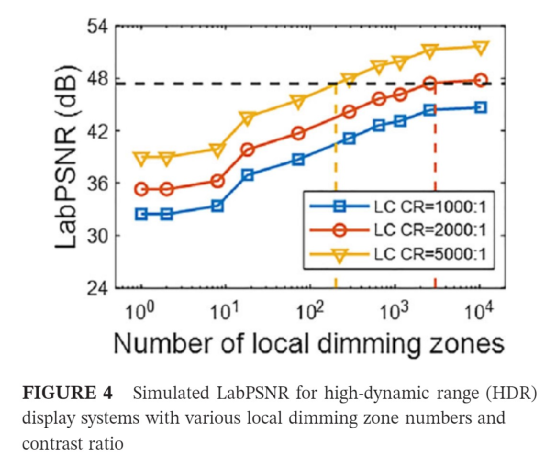
The black dashed line in the image above represents this critical value of LabPSNR. Different colored curves represent different LCD contrast ratios (e.g., blue for a contrast ratio of 1000:1); the horizontal axis indicates the number of backlight zones. (The prerequisite is based on the judgment of a 6.4-inch screen at a viewing distance of 25 cm. Different panel sizes may require consideration of viewing distance, but this data is still of reference value for large panels.)
This chart can also be applied to this year’s iPad Pro to some extent. It is noteworthy that the contrast here refers to the contrast that the LCD liquid crystal itself can achieve, not the contrast of the entire screen after incorporating local dimming technology. For an LCD with a contrast ratio of 2000:1, more than 3,000 backlight zones would be needed to roughly eliminate the impact of the halo effect. However, if the LCD’s inherent contrast ratio is below 1000:1, even with 10,000 zones, satisfactory results cannot be achieved.

Furthermore, for LCD panels, light will diffuse from mini LED backlighting to the liquid crystal layer. This is related to the LED emission aperture, the distance between mini LEDs and the diffuser, and optical layers such as the brightness enhancement film (BEF). The image above shows how the LabPSNR is affected by variations in the number of LEDs (NLED) in a backlight zone when the number of LEDs changes—smaller LED emission apertures and shorter light paths can yield higher LabPSNR.
The yellow, red, and blue curves correspond to different LCD contrast ratios in the previous chart. For instance, when a backlight zone has 2×2 LEDs and a contrast ratio of 2000:1, a σ/xLED of 0.5 means the halo effect becomes negligible (as seen in graph B).
Due to space constraints, this article will not delve into more factors and relationships affecting the halo effect, such as crosstalk from adjacent backlight zones, which is also influenced by optical structures like lens collimation and isolation. Therefore, controlling the boundaries of backlight within zones is also very important. It is evident that there is still room for improvement in current mini LED technology.
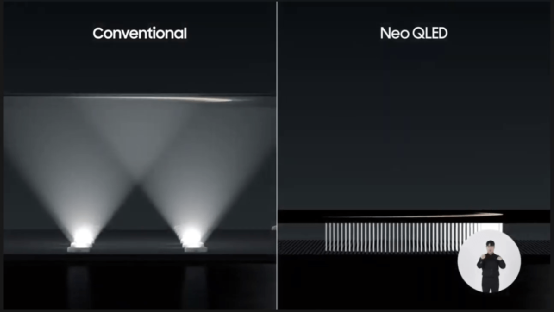
Source: Samsung
The Competition in the Mini LED Market is Intensifying
Overall, although the mini LED screen of the iPad Pro 12.9″ is affected by the halo effect, its stunning performance in brightness and contrast still far exceeds that of similar products, and it has paved the way for the development of mini LED. However, while the price of mini LED is gradually showing advantages, the repair cost for damage to this iPad Pro without Apple Care+ reaches $699, significantly higher than the previous generation’s $499, indicating that the cost of mini LED is still not low.
Fortunately, this situation will soon change. Many panel manufacturers in South Korea and Taiwan are pushing towards mini/micro LED panels, and related supply chain companies in mainland China, including BOE, TCL/Hua Xing Optoelectronics, and Tianma Microelectronics, are increasing their investment in R&D for these two products. In the LED supply chain, manufacturers like Sanan Optoelectronics, Huacan Optoelectronics, Guoxing Optoelectronics, and Jufei Optoelectronics have also been working on related technologies in recent years. (It should be noted that this article discusses mini LED, not micro LED, which is a technology that achieves pixel-level backlight control and is currently still expensive. We will explore this topic in another article.)
For instance, LED chip manufacturer Sanan Optoelectronics has made mini/micro LED a key development strategy, announcing an investment of 1.2 billion yuan in the Ge Town Economic and Technological Development Zone in Ezhou, Hubei, for R&D and production layout in 2019. Last year, Sanan Optoelectronics and Huaxing Optoelectronics announced a partnership to establish a joint laboratory, investing 300 million yuan to jointly develop micro LED materials, manufacturing processes, and equipment.
Additionally, companies like Guoxing Optoelectronics are investing 1 billion yuan to expand LED packaging capacity for mini LED backlighting; Liard and Jingyuan Optoelectronics are jointly investing hundreds of millions of yuan to produce mini/micro LED chips and modules in Wuxi, accelerating the commercialization process of the new generation of display solutions.
Based on the domestic investment in mini/micro LED technology, competition in this market is expected to intensify, accelerating the promotion and development of new technologies. The large-screen products in the market, such as TVs, PCs, and tablets, will soon be affected, marking the beginning of a silent revolution in the display field starting with this year’s iPad Pro.
References:
* Huang, Y, Tan, G, Gou, F, Li, M-C, Lee, S-L, Wu, S-T. Prospects and challenges of mini-LED and micro-LED displays. J Soc Inf Display. 2019; 27: 387– 401. https://doi.org/10.1002/jsid.760.
↓↓ Scan the code to register for the International AIoT Ecological Development Conference ↓↓
